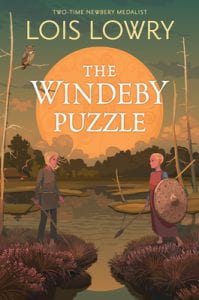 Lowry, Lois. The Windeby Puzzle: History and Story. Clarion Books, 2023. 978-035-867250-0. 186 p. $16.99. Grades 5-7.
Lowry, Lois. The Windeby Puzzle: History and Story. Clarion Books, 2023. 978-035-867250-0. 186 p. $16.99. Grades 5-7.
In May 1952 in northern Germany, men excavating a peat bog discovered skeletal remains, with remarkably preserved hair and clothing remnants. Scientists estimated that this “bog body” was buried in the First Century A.D, during the Iron Age and could find no obvious signs of trauma. At first they believed the body was that of an adolescent female, and she became known as the Windeby Girl. Fascinated by this, Lowry poses a possible explanation to this mystery, after conducting research on that time period. She calls the girl Estrild, and she lives in a village with her family. Her friend is called Varick, who is an orphan boy with a curved spine and other disabilities. Approaching adulthood, Estrild is not looking forward to a future as a wife and mother. Instead, she longs to be a warrior like her brothers and asks Varick, who works with the forger, to help her learn how to use a sword and shield. Soon it is time for the eligible boys to undergo the initiation rites of the warrior. Estrild joins them, declaring before the village and the druids that a woman should have the same opportunities to fight as the males. Those in power make a decision, which ends in tragedy. After writing this story, Lowry learned that a scientist in this century determined that the bog body was that of an adolescent male and so she created a second story from the viewpoint of Varick, who is very curious about nature and how things work. From his study of bones, he is able to successfully treat the forger’s hip injury, but sadly the teenager cannot help himself avoid an unfortunate end. The book is divided into five parts: History, Estrild’s story, History, Varick’s story, and History. The History sections discuss life in the Iron Age and the bog body discovery. There is ample information in the back matter about warrior shields, animals, and customs. The end papers show a photograph of the body, and there are grayscale illustrations by Stroh before each chapter.
THOUGHTS: This is an intriguing book that will attract middle grade readers. One can imagine Estrild as a modern day feminist and Varick a scientist. Even though the reader learns the fate of the characters, there is no narrative discussing their actual deaths. Lowry is a fabulous storyteller, and elementary and middle school libraries will not want to miss this one.
Historical Fiction
